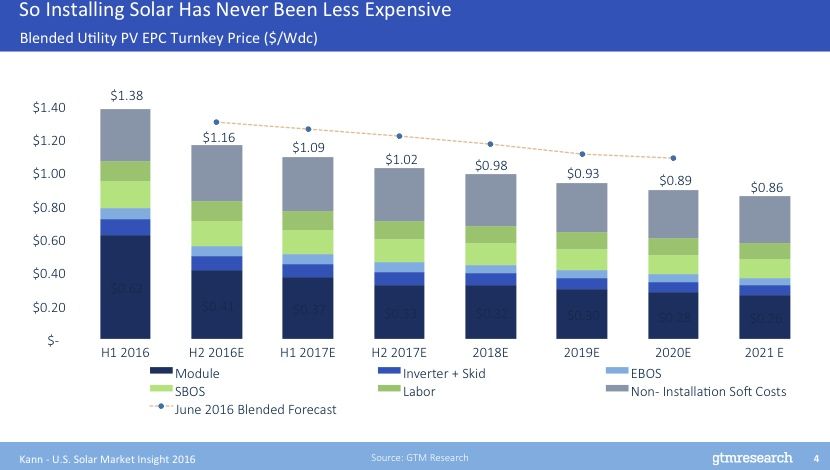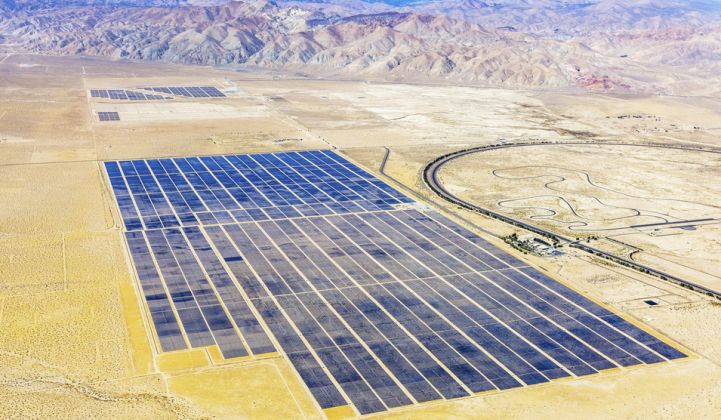8minutenergy Renewables claims to have "the first operational solar PV installation to beat fossil fuel prices in California." The recently commissioned 155-megawatt (AC) Springbok 2 Solar Farm in Kern County will provide electricity to the Los Angeles Department of Water and Power at $35 to $38 per megawatt-hour (adjusted for inflation) over the PPA term.
Is that the lowest-cost PPA ever?
The math is a little fuzzy, and 3.5 cents per kilowatt-hour might not be the lowest PPA price ever, but it's in the ballpark, and a real sign of things to come.
Vital stats of Springbok 2
-
8minutenergy developed the solar farm and D. E. Shaw Renewable Investments put in the majority of the equity. 8minutenergy began developing the project in 2011.
-
It is generating power at $58 per megawatt-hour for the Los Angeles Department of Water and Power (LADWP) with a 30-year PPA.
-
The power offtake partner is Southern California Public Power Authority on behalf of the LADWP.
-
Swinerton Renewable Energy was the engineering, procurement and construction contractor.
-
The power plant is located on approximately "700 acres of abandoned farmland taken out of production more than 20 years ago."
According to GTM Research solar analyst Colin Smith, when GTM calculates PPA prices, it doesn't adjust for inflation, which is what 8minutenergy is doing here. 8minutenergy used the "average U.S. inflation rate over the past 40 years to calculate the equivalent first year price (with inflation as escalator) to Springbok 2’s PPA price and levelized cost of energy (using LADWP’s weighted average cost of capital)."
Smith notes, "That being said, when we compare this to others, it is one of the lowest PPA prices for operating projects -- but not the lowest. For instance, NextEra brought its Chaves County project on-line in October, which we calculated to have an average PPA price of $42.08 per megawatt-hour, with a $36.44 year-one price and a 2 percent escalator."
"We are continuing to see declining prices and have seen sub-$40 per megawatt-hour PPAs before and are going to see more soon," he added. "I wouldn't be shocked to see year-one pricing below $30 per megawatt-hour soon, too. In short, we are going to see PPA prices continue to decline along with declining all-in utility PV costs, driven primarily by declining balance-of-system and module prices."
The biggest risk is the possible rise in interest rates, according to Smith.
Lazard's LCOE numbers
Financial analysts at Lazard recently released the latest version of their levelized cost of electricity (LCOE) analysis.
- Natural gas, the lowest-cost conventional electricity source, costs $52 to $78 per megawatt-hour for a gas-combined cycle plant
- Wind ranges from $32 to $77 per megawatt-hour
- Thin-film utility scale solar PV (from First Solar) produces power at $43 to $60 per megawatt-hour
These are unsubsidized prices.

Source: Lazard
"Ridiculously low PPA prices"
Shayle Kann, the senior VP of GTM Research, in a keynote address at the recent Solar Market Insight Conference in San Diego said, "This is going to be a banner year for solar capacity being added to the grid in the U.S. When all is said and done, solar may well be the top -- if not one of the top two or three -- sources of new electricity generating capacity and, potentially, new generation in the U.S."
"You could see a standard, best-in-class, turnkey, utility-scale project under a $1.00 per watt, this benchmark we've been talking about for almost a decade now, by 2018 -- well before the 2020 SunShot goal," he added.

"2016 is the first year in which the average PPA price for a new utility-scale project in the U.S. is below 5 cents per kilowatt-hour," Kann continued.
"You're probably going to start to see, over the next couple of years, what feel like ridiculously low PPA prices," he said. "You're starting to see this in some international markets. We've seen sub-3 cents per kilowatt-hour PPAs signed in places like Chile, Mexico and the Middle East. You'll start to see that coming in the U.S. as well."
In an earlier interview Jim Hughes, former CEO of First Solar, said, "I fully believe that within 10 years we'll be talking about low-3-cent power on a peak basis."
It looks like Hughes' prediction is going to happen even sooner than he expected.




